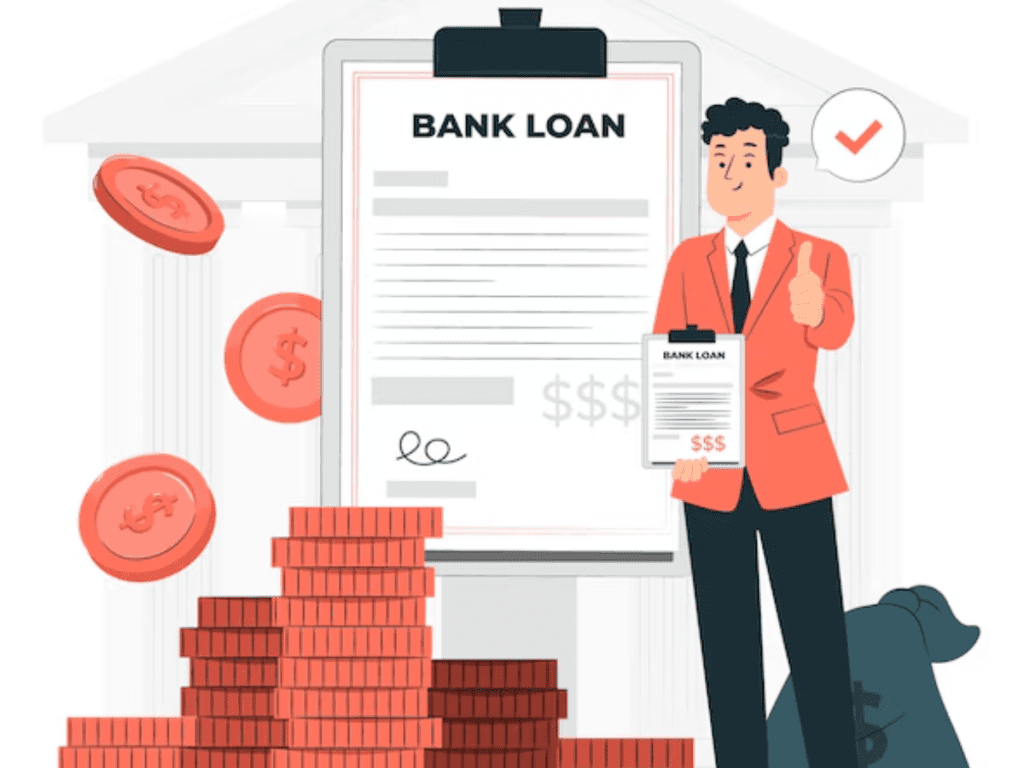Introduction
Lately, loans have become an indispensable tool for financing life’s big occasions, including the acquisition of a home, a vehicle, or the financing of education. For most people, loans offer the badly needed solution to the short-term costs. Though taking simultaneous loans might have its uses as well as hazards, relying on it should also be judged accordingly. If done with responsible payments and prudent budgeting, borrowing several loans can be made effectively. However, if this turns out to lead to greater obligations and trouble due to insufficient revenue, the impact can become dangerous.
This article explores the pros and cons of borrowing multiple loans simultaneously, as well as providing advice on how to juggle multiple loans. It offers a clear explanation of when it may be beneficial to borrow more money, and the pitfalls that borrowers need to be aware of before applying for multiple loans.
The Advantages of Taking Out Multiple Loans Simultaneously
There are a few situations where taking out multiple loans is beneficial for you. Although it might be complicated to deal with multiple loans at the same time, in certain situations, it can bring the money needed to meet several different financial needs, provided that it’s handled strategically. Let’s have a closer look at the advantages.
1. Meeting Several Different Financial Needs All At Once
The most obvious advantage of securing multiple loans is the convenience of meeting different financial requirements simultaneously. For instance, you may require one loan for home repairs, another for clearing medical bills, and a third for purchasing a new vehicle. By obtaining loans for each distinct requirement, you can resolve several financial issues without having to wait until you accumulate sufficient funds for each separate purpose.
Additionally, in the event that you have a sudden financial problem, like a surprise medical need or a major repair to your house, having several loans allows you to be able to resolve these problems as soon as possible without delaying crucial purchases or obligations. Loans allow financial stability with flexibility in addressing unforeseen needs.
2. Creating or Enhancing Your Credit Score
Borrowing several loans may assist you in establishing or enhancing your credit score, provided you pay the loans properly. One important aspect that influences your credit score is the kind of credit you hold and whether or not you are able to repay them. By handling a mix of loans, both secured loans (such as mortgages or auto loans) and unsecured loans (such as credit cards or personal loans), you diversify your credit report and show lenders that you are a competent borrower.
In addition, making regular on-time payments on several loans will positively impact your credit report. Eventually, this enhanced payment history will raise your credit score and enhance your future prospects of getting better loan terms and rates.
3. Lower Interest Rates on Certain Loans
Although borrowing multiple loans means that you have more debt to repay, it also creates the possibility to borrow with quite low interest. For instance, personal loans and home equity loans usually come at lower rates than credit cards or payday loans. If you are eligible for a low-interest loan, taking out several loans may be cheaper in the long term since it could lower the cost of borrowing.
The other advantage of obtaining multiple loans with good rates is that you can consolidate debts at high interest. For example, if you owe money on credit cards or payday loans, it may be worth consolidating the debts into one loan at a lower rate, which can save you money and make your financial responsibilities easier. This tactic works particularly well if you are faced with high-interest debts that are getting hard to handle.
4. Flexible Repayment Terms and Schedules
Most loans offer flexible repayment periods, meaning borrowing more than one loan might enable you to structure your repayment plan according to your budget. For instance, certain loans have longer repayment periods, which translates to lower monthly repayments. This can provide you with more financial flexibility in your budget to cover other financial obligations, including rent, utility bills, or daily living costs.
In addition, having various loans with various due dates may enable you to spread your payments over time, making it easier for you to manage your cash flow. This is especially beneficial if your income varies throughout the year, for example, if you are a freelancer or have seasonal work.
5. Better Cash Flow Management
Having more than one loan does not automatically equal drowning in debt—if managed effectively, it can offer more flexibility in your ability to manage your finances. By taking out varying amounts with different terms for repayment, you can structure your loan payments to be staggered in a manner most comfortable for your cash flow. For instance, you can select loans with various due dates to prevent too many payments coming up at once, and so minimize chances of default or being strapped into cash.
At times, it is possible to get several loans so that you can have access to short-term loans for emergency purposes and also get longer-term loans with lower interest for larger, stable financial obligations. This helps to achieve a balance between having access to money immediately and long-term financial planning.
The Dangers of Borrowing Multiple Loans Concurrently
Although there are significant advantages, securing several loans simultaneously also carries a number of threats. Borrowers must be cautious and consider the implications of how they are going to service the loans in order to prevent adverse financial impacts. Some of the main threats include:
1. Increased Debt Burden
One of the major dangers of acquiring several loans is the mounting debt burden. For every new loan, your total debt amount increases, which will make it tough to service them. This generally results in bigger monthly payments, and if your income level doesn’t rise to support these new commitments, you might find yourself unable to keep up with all your financial responsibilities.
The risk is then increased further if your loans are of a high interest, because you would pay more over the long run. As debt burdens rise, there is an opportunity to take even more debt to pay existing ones, so it becomes challenging to escape debt, which then starts a dangerous vicious cycle.
2. Risk of Default
The more loans that you have, the greater risk there is of missing a payment or defaulting on one of them. Defaulting on a loan can result in severe penalties, such as your credit rating being ruined, increased interest rates on subsequent loans, and threats of legal action against you by lenders. In the most extreme cases, lenders might go so far as wage garnishment or asset seizure to try and recover the loan money.
With several loans, it is more difficult to monitor every payment, and this can result in the possibility of missed deadlines, forgotten due dates, and finally, default. If you are having trouble making payments, it’s important to act fast so that you do not get deeper into debt.
3. Higher Interest Rates and Fees
When borrowing more than one loan, you might realize that the lenders increase the interest rates charged or add extra charges. When you already have a considerable amount of debt, lenders can consider you as a bad credit risk and provide loans with unfavorable terms, like increased interest rates or higher origination fees. The fees tend to add up very fast, and the loans become costlier than they were supposed to be.
Even if you are able to successfully obtain loans with lower interest rates, other charges—like late payment charges, processing charges, or prepayment charges—may nibble into your savings and add to the overall cost of borrowing.
4. Effect on Your Credit Score
Taking out multiple loans can negatively affect your credit score, especially if you’re applying for multiple loans within a short period. Every time a lender checks your credit report, it results in a hard inquiry, which can temporarily lower your credit score. Additionally, having multiple loans increases your credit utilization ratio—the amount of credit you’re using compared to your available credit—which can also hurt your credit score.
Although timely payments can eventually enhance your credit, the initial effect of multiple loans can lower your credit score, which will make it harder to obtain future credit at good rates.
5. Complex Loan Management
Managing several loans simultaneously can be overwhelming, especially when dealing with different interest rates, repayment terms, and due dates. If you’re juggling multiple loans, keeping track of each payment schedule and making sure all obligations are met on time can become difficult. This complexity increases the risk of missing payments, which can lead to late fees and further damage your credit score.
Besides, attempting to pay loans first, either high-interest loans or small balances, can be a herculean task without knowing what to do. The intricacy of dealing with several loans can result in stress, confusion, and eventually, financial mismanagement.
How to Manage Multiple Loans Effectively
If you decide to borrow more than one loan, it’s vital to handle them effectively to escape debt trouble. Here are a few tips to manage multiple loans:
- Develop a Straightforward Debt Payment Plan: Prioritize your loans—paying off the loans with the largest interest rates or the shortest loan terms first. A systematic approach can assist you in staying disciplined and making regular progress toward settling your loans.
- Think About Debt Consolidation: If you have several high-interest loans, rolling them into one loan at a lower interest rate can make it easier to pay them back. Debt consolidation streamlines your finances by grouping several loans into one monthly payment.
- Track Your Cash Flow: Periodically check your expenses and income to make sure you have sufficient funds to cover your monthly loan payments. If necessary, cut back on unnecessary expenses to make room for loan payments.
- Set Up Automatic Payments: To prevent missed payments, consider setting up automatic payments for your loans. This ensures that your payments are always on time, reducing the risk of late fees and credit score damage.
- Obtain Financial Counseling: If you’re having trouble paying off more than one loan, it might be advisable to get financial counseling. They can help you devise a payment plan for your debt and provide tips on how to better manage your finances.
Conclusion
Taking out multiple loans at once offers both benefits and risks. On one hand, it can provide the funds needed to address various financial needs and help build or improve your credit score. On the other hand, it increases your debt load, complicates loan management, and raises the risk of default. Careful consideration and proper planning are key to successfully managing multiple loans and ensuring that they don’t lead to financial hardship.
Before you sign up for several loans, consider the possible gains against the possible costs and check whether you have the means and self-control to handle them well. By being proactive, establishing a straightforward plan for repayment, and keeping track of your finances carefully, you can get the best out of your loans and steer clear of the possible risks involved in borrowing money from several sources.

